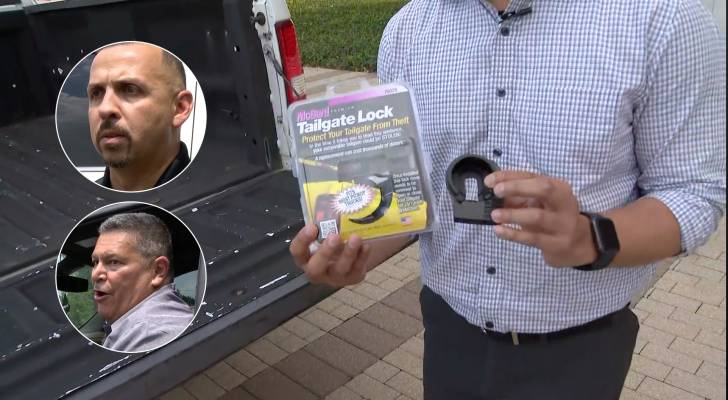A Houston man saw his stolen tailgate online and called the police — and it led to a massive bust of blank key fobs. How these devices are helping car thieves get away in a matter of minutes


An investigation into stolen pickup truck tailgates has uncovered a deeper, more alarming trend in Houston: thieves are using high-tech tools to clone key fobs and drive away with vehicles in under eight minutes. According to the Harris County Sheriff’s Office, victims whose tailgates were stolen worked together to track down the suspects by searching […]
I said I’d cosign an auto loan for my parents and gave them all my details for the paperwork — but then they went to the dealer without me and got completely ripped off. What happens now?


It’s enough to leave any adult child fuming with frustration. You agreed to cosign a car loan for your parents with normal expectations — a limit on how much they’d spend, say $23,000, and an understanding you’d actually get to sign the loan. You hand over your information to help with initial paperwork, then you […]
This Colorado woman swapped her 3,000-square-foot home for a 520-square-foot luxury tiny house on wheels — now she pays just $725/month. Could going small be the big change you need?
When Jen Gressett’s 18-year marriage ended in 2018, she didn’t just need a new place to live — she needed a fresh start. But after selling her 3,000-square-foot home near Boulder, Colorado, she found that traditional housing options were simply out of reach financially. So she got creative. Inspired by the tiny home trend she’d […]
I wanted to spare my kids the burden of student debt — but I made 1 huge mistake with their 529 plan. What I’d do differently if I could go back (and what you can learn from my missteps)
Imagine you’re a diligent parent who, haunted by your own student debt, maxes out a 529 college savings plan for your kids every year to afford a pricey private college. Then life veers off script: Your kids picked more affordable in‑state schools, graduated early and even received help from a generous grandparent. Don’t miss I’m […]
Michigan man left walking to work after his parked car was totaled in a police chase — only days after woman, 71, was killed by another fleeing driver. Why he says the police must ‘do better’
A man in Warren, Michigan, now has to walk to work after a Memorial Day high-speed car chase ended in a crash that totaled his only vehicle. The incident began as a routine traffic stop, when the driver of a Chrysler 300 was pulled over for a tinted window violation. At some point the driver […]
Oakland residents flocking to homesteading amid the high cost of living and fears over political unrest — but does this type of self-sufficiency really make financial sense?


The corner of 28th Street and Martin Luther King Jr. Way in Oakland isn’t where you’d expect to find fruit trees or beehives. Yet nestled between the historic apartments and storefronts, the intersection is now host to a compact urban homestead. Novella Carpenter transformed part of the property into a garden with pomegranate and almond […]
This Knoxville family says their $975/month rental is infested with rats, has no hot water and comes with broken and moldy appliances — and their landlord is blaming them


All parents want a safe place for their family to call home. But Makayla Phillips and her partner, Mikey Johnson, say that’s not what they have. They have a “substandard apartment.” Don’t miss I’m 49 years old and have nothing saved for retirement — what should I do? Don’t panic. Here are 6 of the […]
‘People are fed up’: Michigan residents demand state utility provider stop raising rates as hike request to raise bills by $13/month heads for review — the 4th major increase in 5 years
Residents who recently attended a Michigan Public Service Commission (MPSC) meeting have one unified message for DTE Energy: enough with the rate hikes. "People are fed up," Donavan McKinney, a Michigan state representative, shared with WXYZ Detroit. “They cannot afford more rate increases. People are struggling as is.” Don’t miss I’m 49 years old and […]
‘She’s dangerous’: Judge bans San Diego woman from her former home after 2 suspicious fires and $200K insurance payout vanishes — neighbors say hoarding, threats and chaos went on for years


A San Diego judge has ordered Lisa Golden to stay at least 100 yards away from her Ocean View Hills home after two suspicious fires and the disappearance of a $200,000 insurance payout reports CBS 8 San Diego. Neighbors say the home on Mariner Drive has been a source of stress and fear for years […]
A Montana woman believed Amazon reached out to help protect her identity, but instead was defrauded out of nearly $1 million — how she then helped set up the sting to catch her scammer


An elderly Missoula woman lost nearly $1 million in an elaborate scam involving a fake Amazon support person, the “Social Security Department,” a supposed U.S. Marshal and in-person pickups from her front door, reports the Sacramento Bee. The woman, who was not named, said the scam started with a phone call from a person claiming […]
